The UK Legal System: Sources, Laws, and Business Impact
VerifiedAdded on 2022/11/25
|12
|3739
|2
Report
AI Summary
This report provides a comprehensive overview of the UK legal system, examining various sources of law including legislation, common law, and European Union law. It delves into the law-making authority of the government and the application of statutory and common laws. The report assesses the efficacy of the English legal system in light of contemporary advancements and analyzes the impact of business legislation, such as contract law, company law, and employment law, on potential businesses. It differentiates between legislation, standards, and regulations and explores different types of organizations, including sole proprietorships, partnerships, and limited liability partnerships, along with their formation, management, and funding. Finally, it addresses the advantages and disadvantages of business organizations and briefly discusses dispute resolution methods.

7
Paraphrase This Document
Need a fresh take? Get an instant paraphrase of this document with our AI Paraphraser
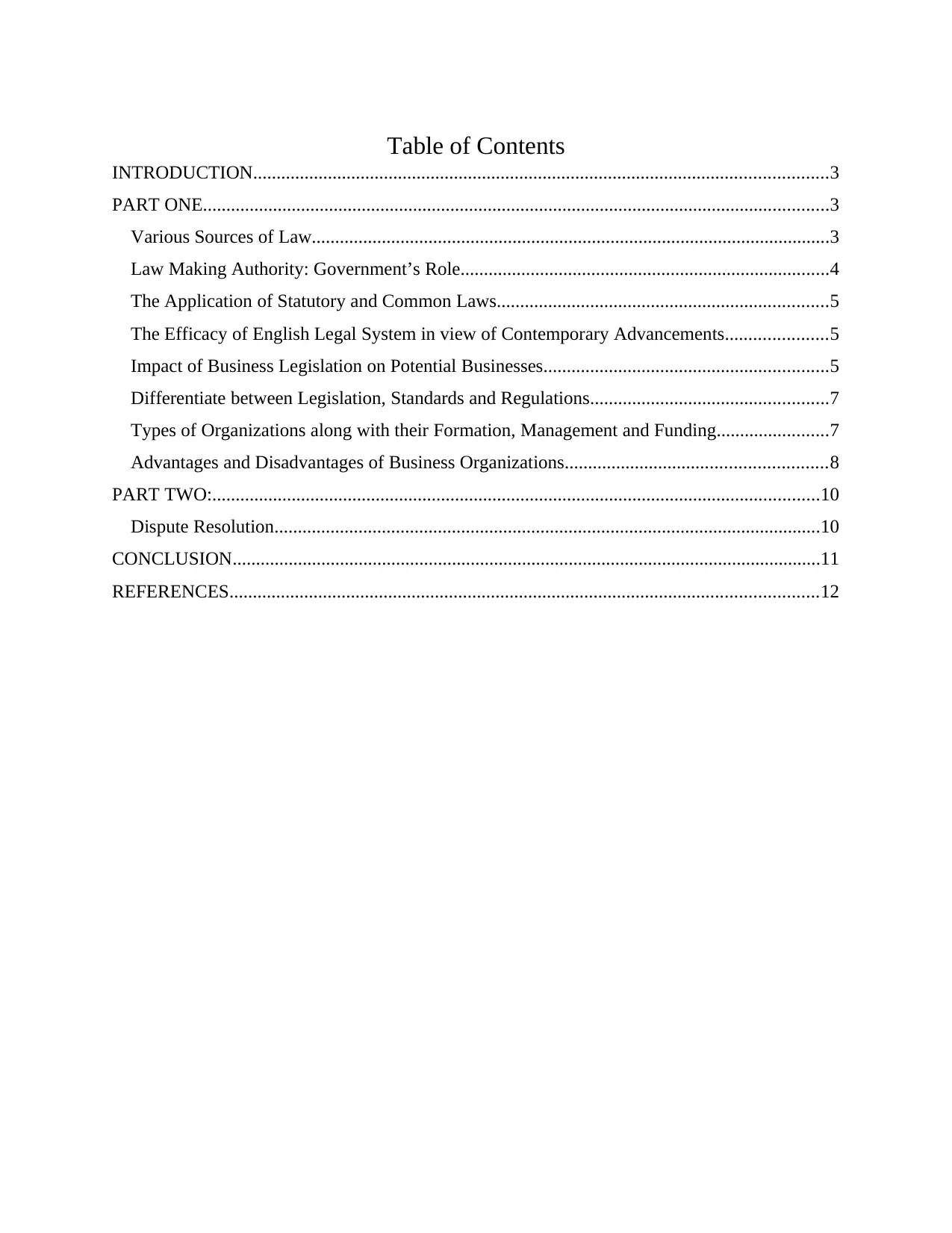
Table of Contents
INTRODUCTION...........................................................................................................................3
PART ONE......................................................................................................................................3
Various Sources of Law...............................................................................................................3
Law Making Authority: Government’s Role...............................................................................4
The Application of Statutory and Common Laws.......................................................................5
The Efficacy of English Legal System in view of Contemporary Advancements......................5
Impact of Business Legislation on Potential Businesses.............................................................5
Differentiate between Legislation, Standards and Regulations...................................................7
Types of Organizations along with their Formation, Management and Funding........................7
Advantages and Disadvantages of Business Organizations........................................................8
PART TWO:..................................................................................................................................10
Dispute Resolution.....................................................................................................................10
CONCLUSION..............................................................................................................................11
REFERENCES..............................................................................................................................12
INTRODUCTION...........................................................................................................................3
PART ONE......................................................................................................................................3
Various Sources of Law...............................................................................................................3
Law Making Authority: Government’s Role...............................................................................4
The Application of Statutory and Common Laws.......................................................................5
The Efficacy of English Legal System in view of Contemporary Advancements......................5
Impact of Business Legislation on Potential Businesses.............................................................5
Differentiate between Legislation, Standards and Regulations...................................................7
Types of Organizations along with their Formation, Management and Funding........................7
Advantages and Disadvantages of Business Organizations........................................................8
PART TWO:..................................................................................................................................10
Dispute Resolution.....................................................................................................................10
CONCLUSION..............................................................................................................................11
REFERENCES..............................................................................................................................12
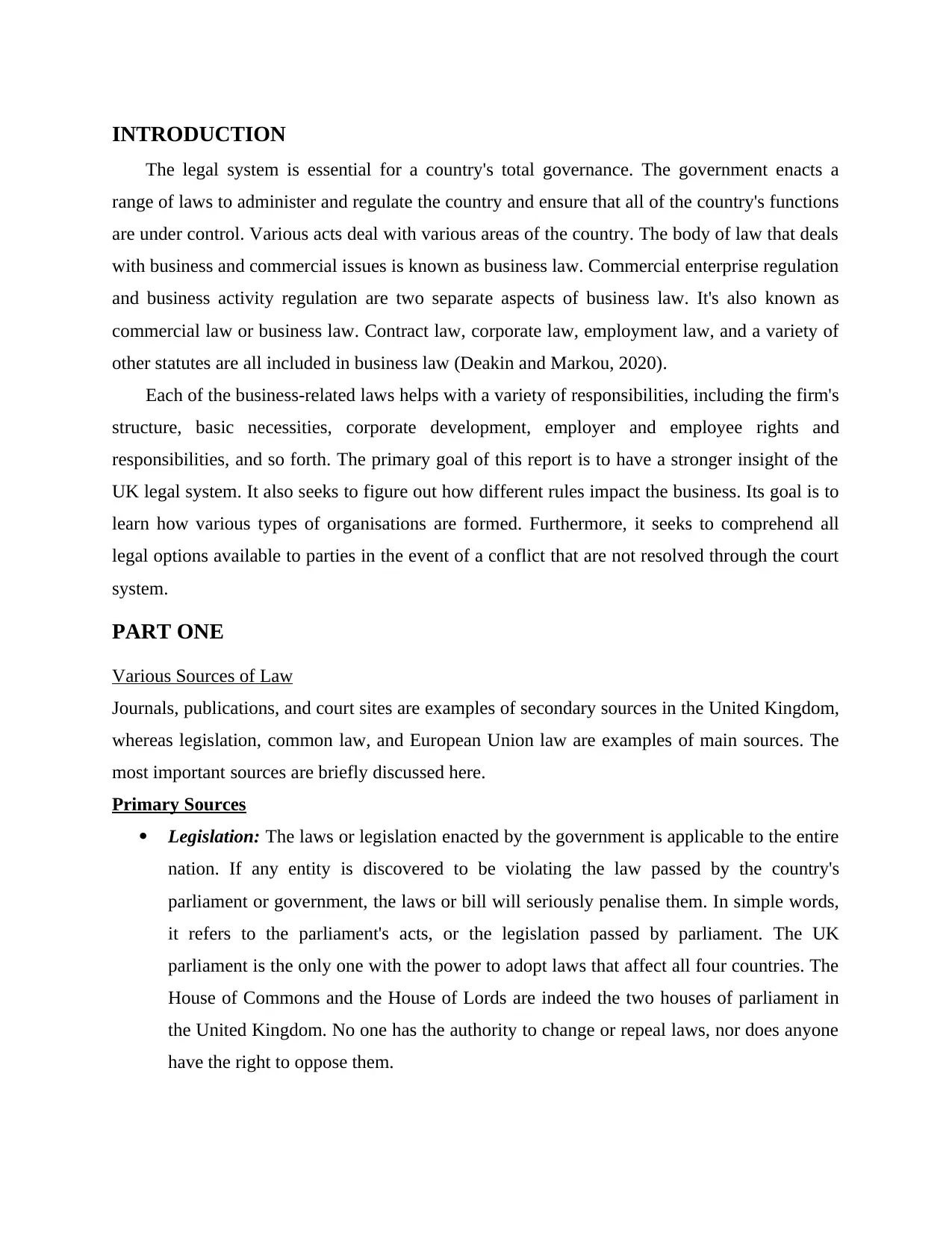
INTRODUCTION
The legal system is essential for a country's total governance. The government enacts a
range of laws to administer and regulate the country and ensure that all of the country's functions
are under control. Various acts deal with various areas of the country. The body of law that deals
with business and commercial issues is known as business law. Commercial enterprise regulation
and business activity regulation are two separate aspects of business law. It's also known as
commercial law or business law. Contract law, corporate law, employment law, and a variety of
other statutes are all included in business law (Deakin and Markou, 2020).
Each of the business-related laws helps with a variety of responsibilities, including the firm's
structure, basic necessities, corporate development, employer and employee rights and
responsibilities, and so forth. The primary goal of this report is to have a stronger insight of the
UK legal system. It also seeks to figure out how different rules impact the business. Its goal is to
learn how various types of organisations are formed. Furthermore, it seeks to comprehend all
legal options available to parties in the event of a conflict that are not resolved through the court
system.
PART ONE
Various Sources of Law
Journals, publications, and court sites are examples of secondary sources in the United Kingdom,
whereas legislation, common law, and European Union law are examples of main sources. The
most important sources are briefly discussed here.
Primary Sources
Legislation: The laws or legislation enacted by the government is applicable to the entire
nation. If any entity is discovered to be violating the law passed by the country's
parliament or government, the laws or bill will seriously penalise them. In simple words,
it refers to the parliament's acts, or the legislation passed by parliament. The UK
parliament is the only one with the power to adopt laws that affect all four countries. The
House of Commons and the House of Lords are indeed the two houses of parliament in
the United Kingdom. No one has the authority to change or repeal laws, nor does anyone
have the right to oppose them.
The legal system is essential for a country's total governance. The government enacts a
range of laws to administer and regulate the country and ensure that all of the country's functions
are under control. Various acts deal with various areas of the country. The body of law that deals
with business and commercial issues is known as business law. Commercial enterprise regulation
and business activity regulation are two separate aspects of business law. It's also known as
commercial law or business law. Contract law, corporate law, employment law, and a variety of
other statutes are all included in business law (Deakin and Markou, 2020).
Each of the business-related laws helps with a variety of responsibilities, including the firm's
structure, basic necessities, corporate development, employer and employee rights and
responsibilities, and so forth. The primary goal of this report is to have a stronger insight of the
UK legal system. It also seeks to figure out how different rules impact the business. Its goal is to
learn how various types of organisations are formed. Furthermore, it seeks to comprehend all
legal options available to parties in the event of a conflict that are not resolved through the court
system.
PART ONE
Various Sources of Law
Journals, publications, and court sites are examples of secondary sources in the United Kingdom,
whereas legislation, common law, and European Union law are examples of main sources. The
most important sources are briefly discussed here.
Primary Sources
Legislation: The laws or legislation enacted by the government is applicable to the entire
nation. If any entity is discovered to be violating the law passed by the country's
parliament or government, the laws or bill will seriously penalise them. In simple words,
it refers to the parliament's acts, or the legislation passed by parliament. The UK
parliament is the only one with the power to adopt laws that affect all four countries. The
House of Commons and the House of Lords are indeed the two houses of parliament in
the United Kingdom. No one has the authority to change or repeal laws, nor does anyone
have the right to oppose them.
⊘ This is a preview!⊘
Do you want full access?
Subscribe today to unlock all pages.

Trusted by 1+ million students worldwide
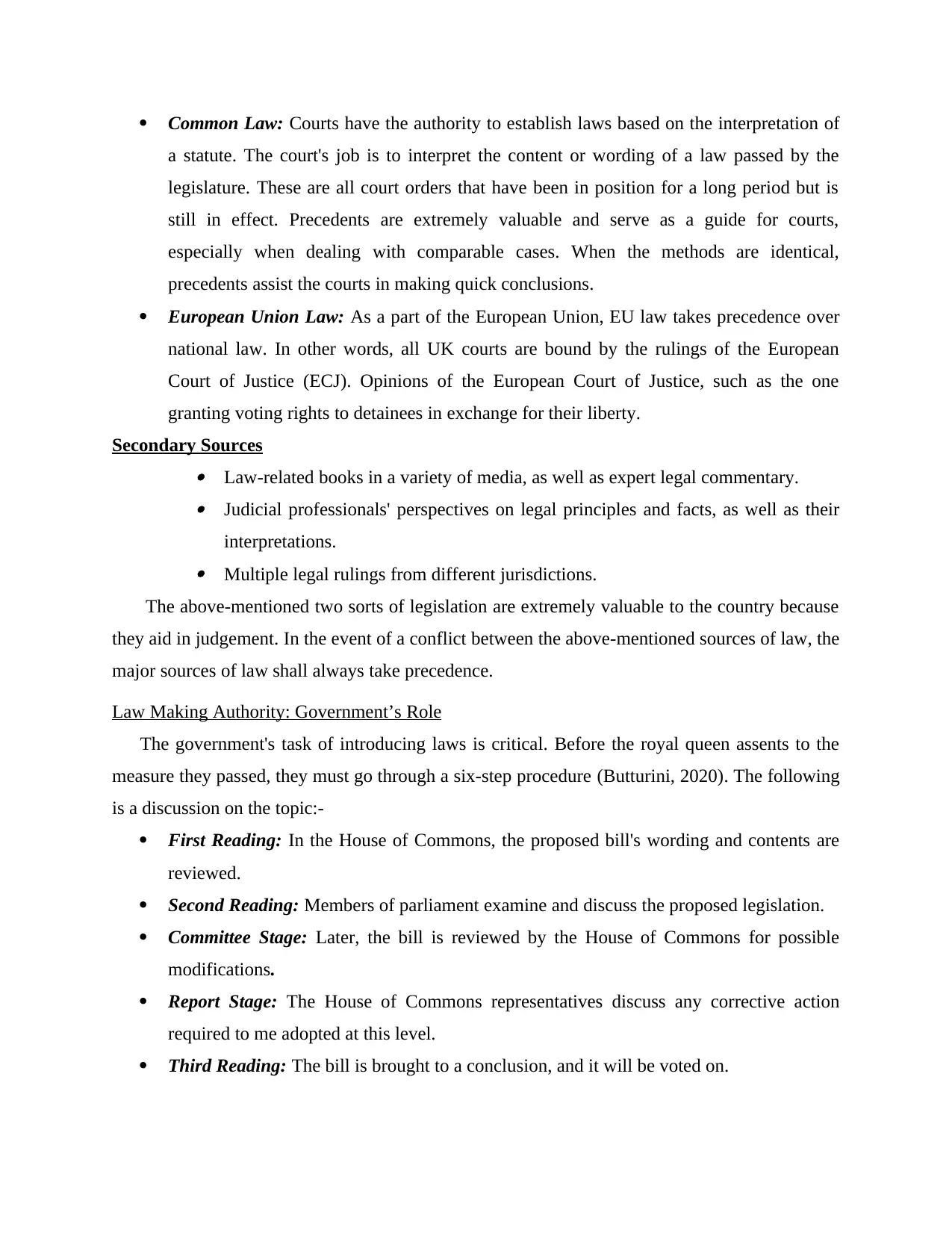
Common Law: Courts have the authority to establish laws based on the interpretation of
a statute. The court's job is to interpret the content or wording of a law passed by the
legislature. These are all court orders that have been in position for a long period but is
still in effect. Precedents are extremely valuable and serve as a guide for courts,
especially when dealing with comparable cases. When the methods are identical,
precedents assist the courts in making quick conclusions.
European Union Law: As a part of the European Union, EU law takes precedence over
national law. In other words, all UK courts are bound by the rulings of the European
Court of Justice (ECJ). Opinions of the European Court of Justice, such as the one
granting voting rights to detainees in exchange for their liberty.
Secondary Sources
Law-related books in a variety of media, as well as expert legal commentary.
Judicial professionals' perspectives on legal principles and facts, as well as their
interpretations.
Multiple legal rulings from different jurisdictions.
The above-mentioned two sorts of legislation are extremely valuable to the country because
they aid in judgement. In the event of a conflict between the above-mentioned sources of law, the
major sources of law shall always take precedence.
Law Making Authority: Government’s Role
The government's task of introducing laws is critical. Before the royal queen assents to the
measure they passed, they must go through a six-step procedure (Butturini, 2020). The following
is a discussion on the topic:-
First Reading: In the House of Commons, the proposed bill's wording and contents are
reviewed.
Second Reading: Members of parliament examine and discuss the proposed legislation.
Committee Stage: Later, the bill is reviewed by the House of Commons for possible
modifications.
Report Stage: The House of Commons representatives discuss any corrective action
required to me adopted at this level.
Third Reading: The bill is brought to a conclusion, and it will be voted on.
a statute. The court's job is to interpret the content or wording of a law passed by the
legislature. These are all court orders that have been in position for a long period but is
still in effect. Precedents are extremely valuable and serve as a guide for courts,
especially when dealing with comparable cases. When the methods are identical,
precedents assist the courts in making quick conclusions.
European Union Law: As a part of the European Union, EU law takes precedence over
national law. In other words, all UK courts are bound by the rulings of the European
Court of Justice (ECJ). Opinions of the European Court of Justice, such as the one
granting voting rights to detainees in exchange for their liberty.
Secondary Sources
Law-related books in a variety of media, as well as expert legal commentary.
Judicial professionals' perspectives on legal principles and facts, as well as their
interpretations.
Multiple legal rulings from different jurisdictions.
The above-mentioned two sorts of legislation are extremely valuable to the country because
they aid in judgement. In the event of a conflict between the above-mentioned sources of law, the
major sources of law shall always take precedence.
Law Making Authority: Government’s Role
The government's task of introducing laws is critical. Before the royal queen assents to the
measure they passed, they must go through a six-step procedure (Butturini, 2020). The following
is a discussion on the topic:-
First Reading: In the House of Commons, the proposed bill's wording and contents are
reviewed.
Second Reading: Members of parliament examine and discuss the proposed legislation.
Committee Stage: Later, the bill is reviewed by the House of Commons for possible
modifications.
Report Stage: The House of Commons representatives discuss any corrective action
required to me adopted at this level.
Third Reading: The bill is brought to a conclusion, and it will be voted on.
Paraphrase This Document
Need a fresh take? Get an instant paraphrase of this document with our AI Paraphraser
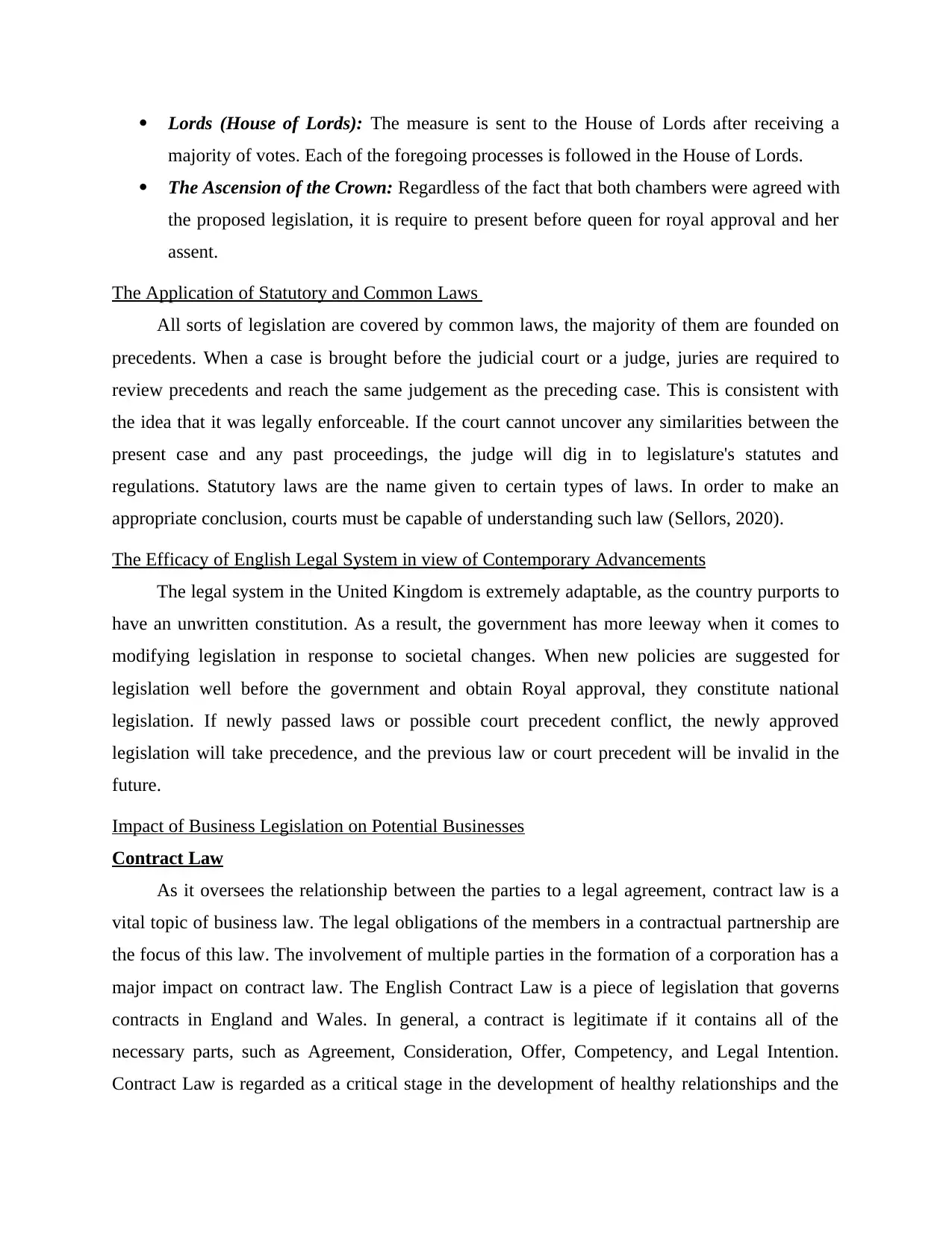
Lords (House of Lords): The measure is sent to the House of Lords after receiving a
majority of votes. Each of the foregoing processes is followed in the House of Lords.
The Ascension of the Crown: Regardless of the fact that both chambers were agreed with
the proposed legislation, it is require to present before queen for royal approval and her
assent.
The Application of Statutory and Common Laws
All sorts of legislation are covered by common laws, the majority of them are founded on
precedents. When a case is brought before the judicial court or a judge, juries are required to
review precedents and reach the same judgement as the preceding case. This is consistent with
the idea that it was legally enforceable. If the court cannot uncover any similarities between the
present case and any past proceedings, the judge will dig in to legislature's statutes and
regulations. Statutory laws are the name given to certain types of laws. In order to make an
appropriate conclusion, courts must be capable of understanding such law (Sellors, 2020).
The Efficacy of English Legal System in view of Contemporary Advancements
The legal system in the United Kingdom is extremely adaptable, as the country purports to
have an unwritten constitution. As a result, the government has more leeway when it comes to
modifying legislation in response to societal changes. When new policies are suggested for
legislation well before the government and obtain Royal approval, they constitute national
legislation. If newly passed laws or possible court precedent conflict, the newly approved
legislation will take precedence, and the previous law or court precedent will be invalid in the
future.
Impact of Business Legislation on Potential Businesses
Contract Law
As it oversees the relationship between the parties to a legal agreement, contract law is a
vital topic of business law. The legal obligations of the members in a contractual partnership are
the focus of this law. The involvement of multiple parties in the formation of a corporation has a
major impact on contract law. The English Contract Law is a piece of legislation that governs
contracts in England and Wales. In general, a contract is legitimate if it contains all of the
necessary parts, such as Agreement, Consideration, Offer, Competency, and Legal Intention.
Contract Law is regarded as a critical stage in the development of healthy relationships and the
majority of votes. Each of the foregoing processes is followed in the House of Lords.
The Ascension of the Crown: Regardless of the fact that both chambers were agreed with
the proposed legislation, it is require to present before queen for royal approval and her
assent.
The Application of Statutory and Common Laws
All sorts of legislation are covered by common laws, the majority of them are founded on
precedents. When a case is brought before the judicial court or a judge, juries are required to
review precedents and reach the same judgement as the preceding case. This is consistent with
the idea that it was legally enforceable. If the court cannot uncover any similarities between the
present case and any past proceedings, the judge will dig in to legislature's statutes and
regulations. Statutory laws are the name given to certain types of laws. In order to make an
appropriate conclusion, courts must be capable of understanding such law (Sellors, 2020).
The Efficacy of English Legal System in view of Contemporary Advancements
The legal system in the United Kingdom is extremely adaptable, as the country purports to
have an unwritten constitution. As a result, the government has more leeway when it comes to
modifying legislation in response to societal changes. When new policies are suggested for
legislation well before the government and obtain Royal approval, they constitute national
legislation. If newly passed laws or possible court precedent conflict, the newly approved
legislation will take precedence, and the previous law or court precedent will be invalid in the
future.
Impact of Business Legislation on Potential Businesses
Contract Law
As it oversees the relationship between the parties to a legal agreement, contract law is a
vital topic of business law. The legal obligations of the members in a contractual partnership are
the focus of this law. The involvement of multiple parties in the formation of a corporation has a
major impact on contract law. The English Contract Law is a piece of legislation that governs
contracts in England and Wales. In general, a contract is legitimate if it contains all of the
necessary parts, such as Agreement, Consideration, Offer, Competency, and Legal Intention.
Contract Law is regarded as a critical stage in the development of healthy relationships and the
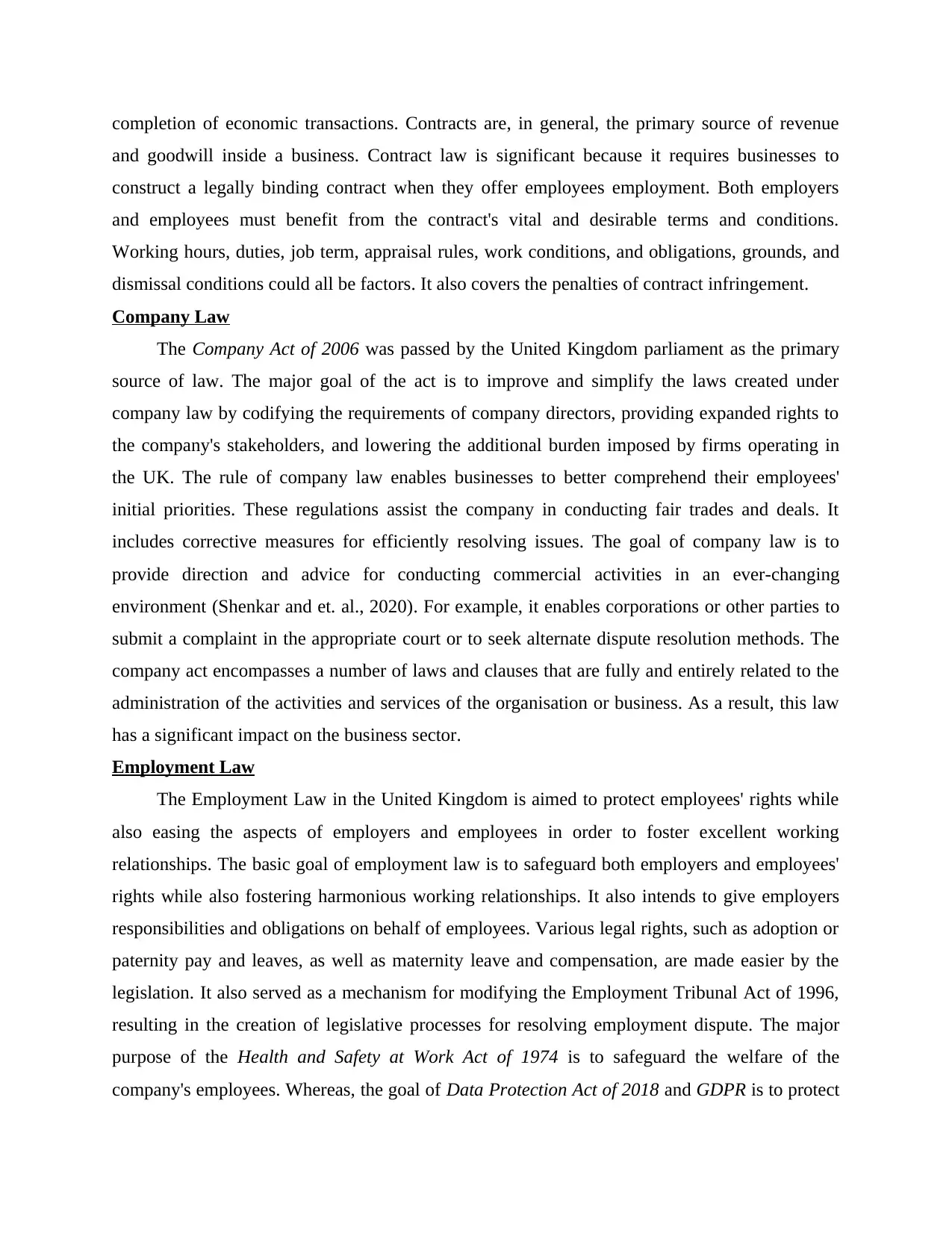
completion of economic transactions. Contracts are, in general, the primary source of revenue
and goodwill inside a business. Contract law is significant because it requires businesses to
construct a legally binding contract when they offer employees employment. Both employers
and employees must benefit from the contract's vital and desirable terms and conditions.
Working hours, duties, job term, appraisal rules, work conditions, and obligations, grounds, and
dismissal conditions could all be factors. It also covers the penalties of contract infringement.
Company Law
The Company Act of 2006 was passed by the United Kingdom parliament as the primary
source of law. The major goal of the act is to improve and simplify the laws created under
company law by codifying the requirements of company directors, providing expanded rights to
the company's stakeholders, and lowering the additional burden imposed by firms operating in
the UK. The rule of company law enables businesses to better comprehend their employees'
initial priorities. These regulations assist the company in conducting fair trades and deals. It
includes corrective measures for efficiently resolving issues. The goal of company law is to
provide direction and advice for conducting commercial activities in an ever-changing
environment (Shenkar and et. al., 2020). For example, it enables corporations or other parties to
submit a complaint in the appropriate court or to seek alternate dispute resolution methods. The
company act encompasses a number of laws and clauses that are fully and entirely related to the
administration of the activities and services of the organisation or business. As a result, this law
has a significant impact on the business sector.
Employment Law
The Employment Law in the United Kingdom is aimed to protect employees' rights while
also easing the aspects of employers and employees in order to foster excellent working
relationships. The basic goal of employment law is to safeguard both employers and employees'
rights while also fostering harmonious working relationships. It also intends to give employers
responsibilities and obligations on behalf of employees. Various legal rights, such as adoption or
paternity pay and leaves, as well as maternity leave and compensation, are made easier by the
legislation. It also served as a mechanism for modifying the Employment Tribunal Act of 1996,
resulting in the creation of legislative processes for resolving employment dispute. The major
purpose of the Health and Safety at Work Act of 1974 is to safeguard the welfare of the
company's employees. Whereas, the goal of Data Protection Act of 2018 and GDPR is to protect
and goodwill inside a business. Contract law is significant because it requires businesses to
construct a legally binding contract when they offer employees employment. Both employers
and employees must benefit from the contract's vital and desirable terms and conditions.
Working hours, duties, job term, appraisal rules, work conditions, and obligations, grounds, and
dismissal conditions could all be factors. It also covers the penalties of contract infringement.
Company Law
The Company Act of 2006 was passed by the United Kingdom parliament as the primary
source of law. The major goal of the act is to improve and simplify the laws created under
company law by codifying the requirements of company directors, providing expanded rights to
the company's stakeholders, and lowering the additional burden imposed by firms operating in
the UK. The rule of company law enables businesses to better comprehend their employees'
initial priorities. These regulations assist the company in conducting fair trades and deals. It
includes corrective measures for efficiently resolving issues. The goal of company law is to
provide direction and advice for conducting commercial activities in an ever-changing
environment (Shenkar and et. al., 2020). For example, it enables corporations or other parties to
submit a complaint in the appropriate court or to seek alternate dispute resolution methods. The
company act encompasses a number of laws and clauses that are fully and entirely related to the
administration of the activities and services of the organisation or business. As a result, this law
has a significant impact on the business sector.
Employment Law
The Employment Law in the United Kingdom is aimed to protect employees' rights while
also easing the aspects of employers and employees in order to foster excellent working
relationships. The basic goal of employment law is to safeguard both employers and employees'
rights while also fostering harmonious working relationships. It also intends to give employers
responsibilities and obligations on behalf of employees. Various legal rights, such as adoption or
paternity pay and leaves, as well as maternity leave and compensation, are made easier by the
legislation. It also served as a mechanism for modifying the Employment Tribunal Act of 1996,
resulting in the creation of legislative processes for resolving employment dispute. The major
purpose of the Health and Safety at Work Act of 1974 is to safeguard the welfare of the
company's employees. Whereas, the goal of Data Protection Act of 2018 and GDPR is to protect
⊘ This is a preview!⊘
Do you want full access?
Subscribe today to unlock all pages.

Trusted by 1+ million students worldwide
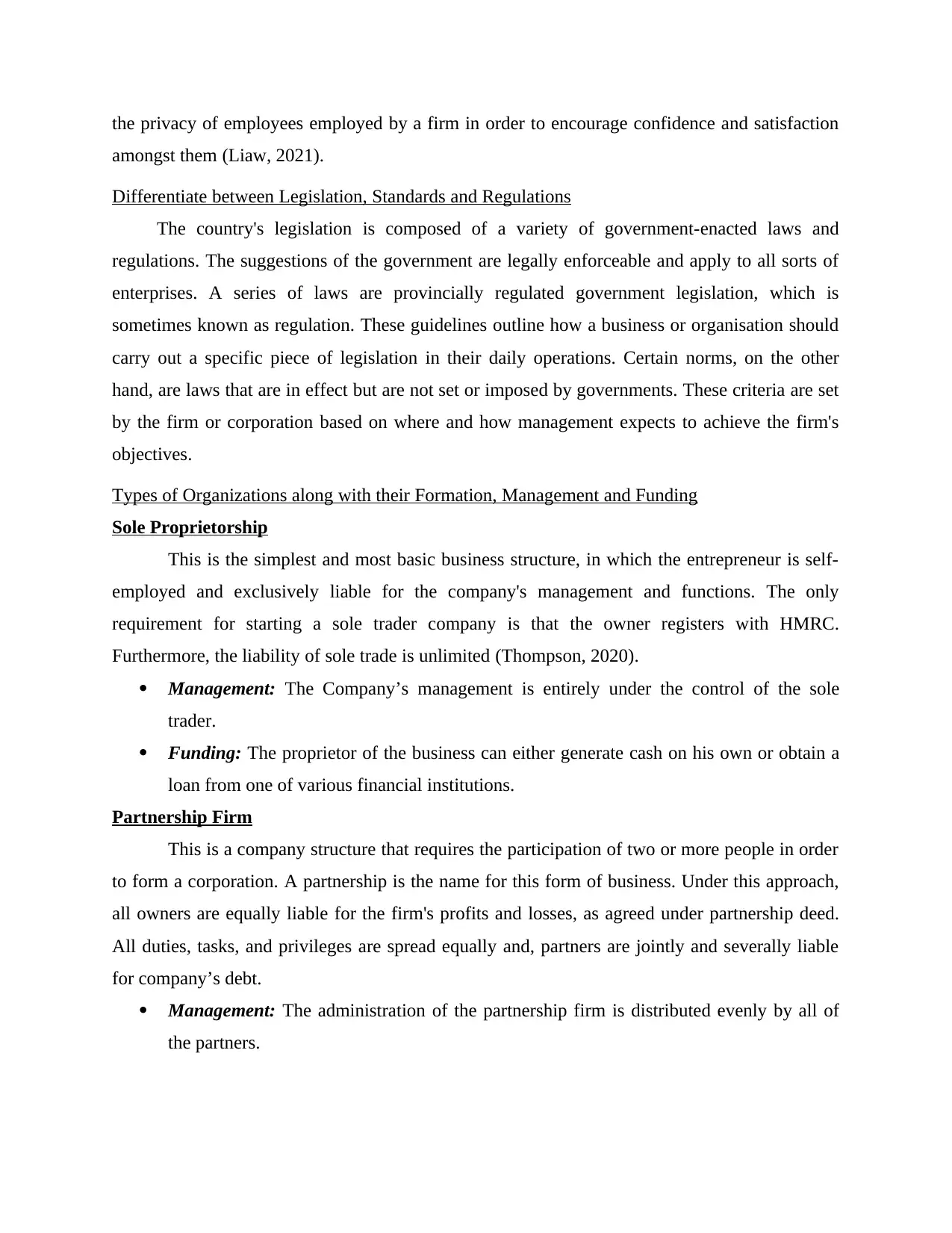
the privacy of employees employed by a firm in order to encourage confidence and satisfaction
amongst them (Liaw, 2021).
Differentiate between Legislation, Standards and Regulations
The country's legislation is composed of a variety of government-enacted laws and
regulations. The suggestions of the government are legally enforceable and apply to all sorts of
enterprises. A series of laws are provincially regulated government legislation, which is
sometimes known as regulation. These guidelines outline how a business or organisation should
carry out a specific piece of legislation in their daily operations. Certain norms, on the other
hand, are laws that are in effect but are not set or imposed by governments. These criteria are set
by the firm or corporation based on where and how management expects to achieve the firm's
objectives.
Types of Organizations along with their Formation, Management and Funding
Sole Proprietorship
This is the simplest and most basic business structure, in which the entrepreneur is self-
employed and exclusively liable for the company's management and functions. The only
requirement for starting a sole trader company is that the owner registers with HMRC.
Furthermore, the liability of sole trade is unlimited (Thompson, 2020).
Management: The Company’s management is entirely under the control of the sole
trader.
Funding: The proprietor of the business can either generate cash on his own or obtain a
loan from one of various financial institutions.
Partnership Firm
This is a company structure that requires the participation of two or more people in order
to form a corporation. A partnership is the name for this form of business. Under this approach,
all owners are equally liable for the firm's profits and losses, as agreed under partnership deed.
All duties, tasks, and privileges are spread equally and, partners are jointly and severally liable
for company’s debt.
Management: The administration of the partnership firm is distributed evenly by all of
the partners.
amongst them (Liaw, 2021).
Differentiate between Legislation, Standards and Regulations
The country's legislation is composed of a variety of government-enacted laws and
regulations. The suggestions of the government are legally enforceable and apply to all sorts of
enterprises. A series of laws are provincially regulated government legislation, which is
sometimes known as regulation. These guidelines outline how a business or organisation should
carry out a specific piece of legislation in their daily operations. Certain norms, on the other
hand, are laws that are in effect but are not set or imposed by governments. These criteria are set
by the firm or corporation based on where and how management expects to achieve the firm's
objectives.
Types of Organizations along with their Formation, Management and Funding
Sole Proprietorship
This is the simplest and most basic business structure, in which the entrepreneur is self-
employed and exclusively liable for the company's management and functions. The only
requirement for starting a sole trader company is that the owner registers with HMRC.
Furthermore, the liability of sole trade is unlimited (Thompson, 2020).
Management: The Company’s management is entirely under the control of the sole
trader.
Funding: The proprietor of the business can either generate cash on his own or obtain a
loan from one of various financial institutions.
Partnership Firm
This is a company structure that requires the participation of two or more people in order
to form a corporation. A partnership is the name for this form of business. Under this approach,
all owners are equally liable for the firm's profits and losses, as agreed under partnership deed.
All duties, tasks, and privileges are spread equally and, partners are jointly and severally liable
for company’s debt.
Management: The administration of the partnership firm is distributed evenly by all of
the partners.
Paraphrase This Document
Need a fresh take? Get an instant paraphrase of this document with our AI Paraphraser
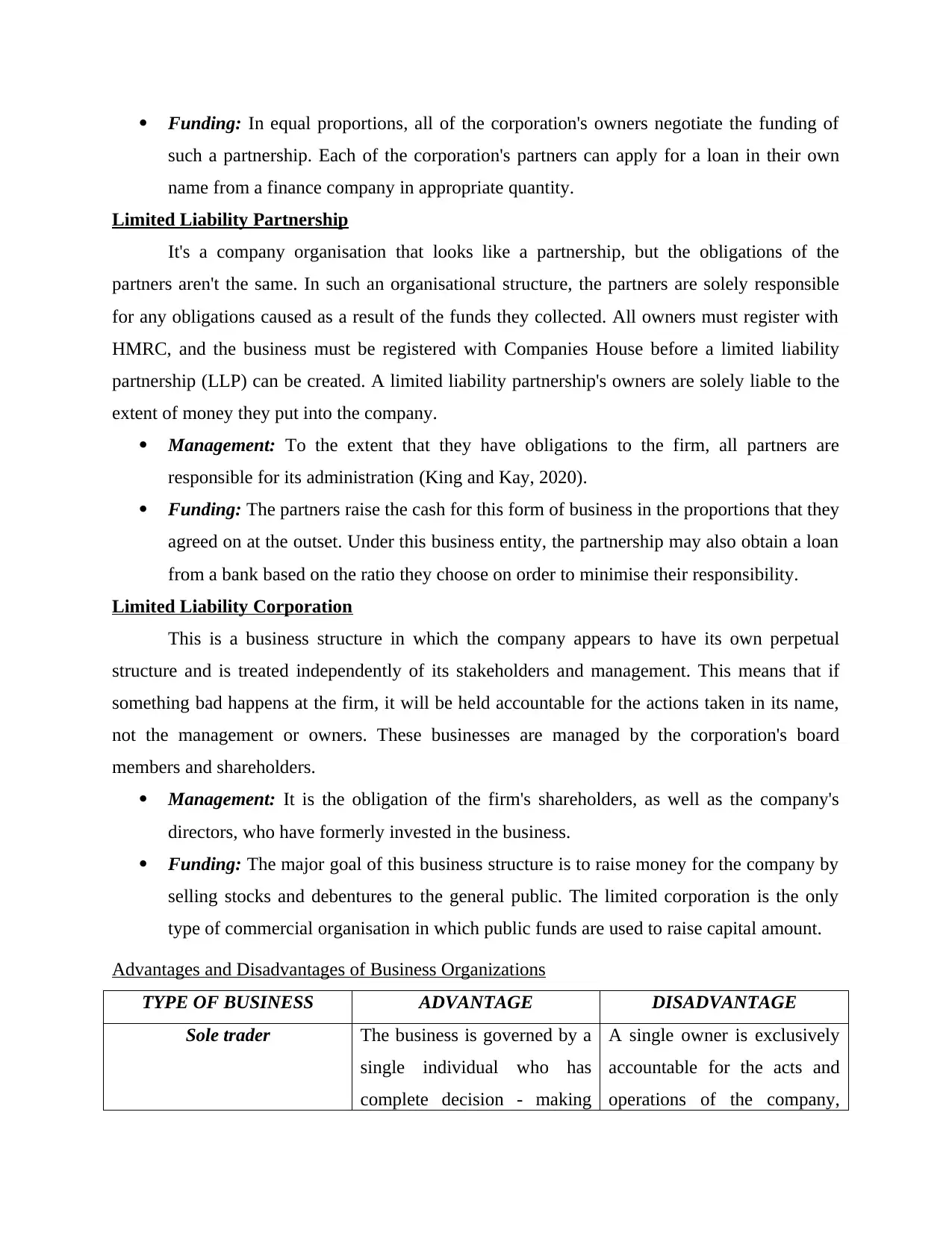
Funding: In equal proportions, all of the corporation's owners negotiate the funding of
such a partnership. Each of the corporation's partners can apply for a loan in their own
name from a finance company in appropriate quantity.
Limited Liability Partnership
It's a company organisation that looks like a partnership, but the obligations of the
partners aren't the same. In such an organisational structure, the partners are solely responsible
for any obligations caused as a result of the funds they collected. All owners must register with
HMRC, and the business must be registered with Companies House before a limited liability
partnership (LLP) can be created. A limited liability partnership's owners are solely liable to the
extent of money they put into the company.
Management: To the extent that they have obligations to the firm, all partners are
responsible for its administration (King and Kay, 2020).
Funding: The partners raise the cash for this form of business in the proportions that they
agreed on at the outset. Under this business entity, the partnership may also obtain a loan
from a bank based on the ratio they choose on order to minimise their responsibility.
Limited Liability Corporation
This is a business structure in which the company appears to have its own perpetual
structure and is treated independently of its stakeholders and management. This means that if
something bad happens at the firm, it will be held accountable for the actions taken in its name,
not the management or owners. These businesses are managed by the corporation's board
members and shareholders.
Management: It is the obligation of the firm's shareholders, as well as the company's
directors, who have formerly invested in the business.
Funding: The major goal of this business structure is to raise money for the company by
selling stocks and debentures to the general public. The limited corporation is the only
type of commercial organisation in which public funds are used to raise capital amount.
Advantages and Disadvantages of Business Organizations
TYPE OF BUSINESS ADVANTAGE DISADVANTAGE
Sole trader The business is governed by a
single individual who has
complete decision - making
A single owner is exclusively
accountable for the acts and
operations of the company,
such a partnership. Each of the corporation's partners can apply for a loan in their own
name from a finance company in appropriate quantity.
Limited Liability Partnership
It's a company organisation that looks like a partnership, but the obligations of the
partners aren't the same. In such an organisational structure, the partners are solely responsible
for any obligations caused as a result of the funds they collected. All owners must register with
HMRC, and the business must be registered with Companies House before a limited liability
partnership (LLP) can be created. A limited liability partnership's owners are solely liable to the
extent of money they put into the company.
Management: To the extent that they have obligations to the firm, all partners are
responsible for its administration (King and Kay, 2020).
Funding: The partners raise the cash for this form of business in the proportions that they
agreed on at the outset. Under this business entity, the partnership may also obtain a loan
from a bank based on the ratio they choose on order to minimise their responsibility.
Limited Liability Corporation
This is a business structure in which the company appears to have its own perpetual
structure and is treated independently of its stakeholders and management. This means that if
something bad happens at the firm, it will be held accountable for the actions taken in its name,
not the management or owners. These businesses are managed by the corporation's board
members and shareholders.
Management: It is the obligation of the firm's shareholders, as well as the company's
directors, who have formerly invested in the business.
Funding: The major goal of this business structure is to raise money for the company by
selling stocks and debentures to the general public. The limited corporation is the only
type of commercial organisation in which public funds are used to raise capital amount.
Advantages and Disadvantages of Business Organizations
TYPE OF BUSINESS ADVANTAGE DISADVANTAGE
Sole trader The business is governed by a
single individual who has
complete decision - making
A single owner is exclusively
accountable for the acts and
operations of the company,
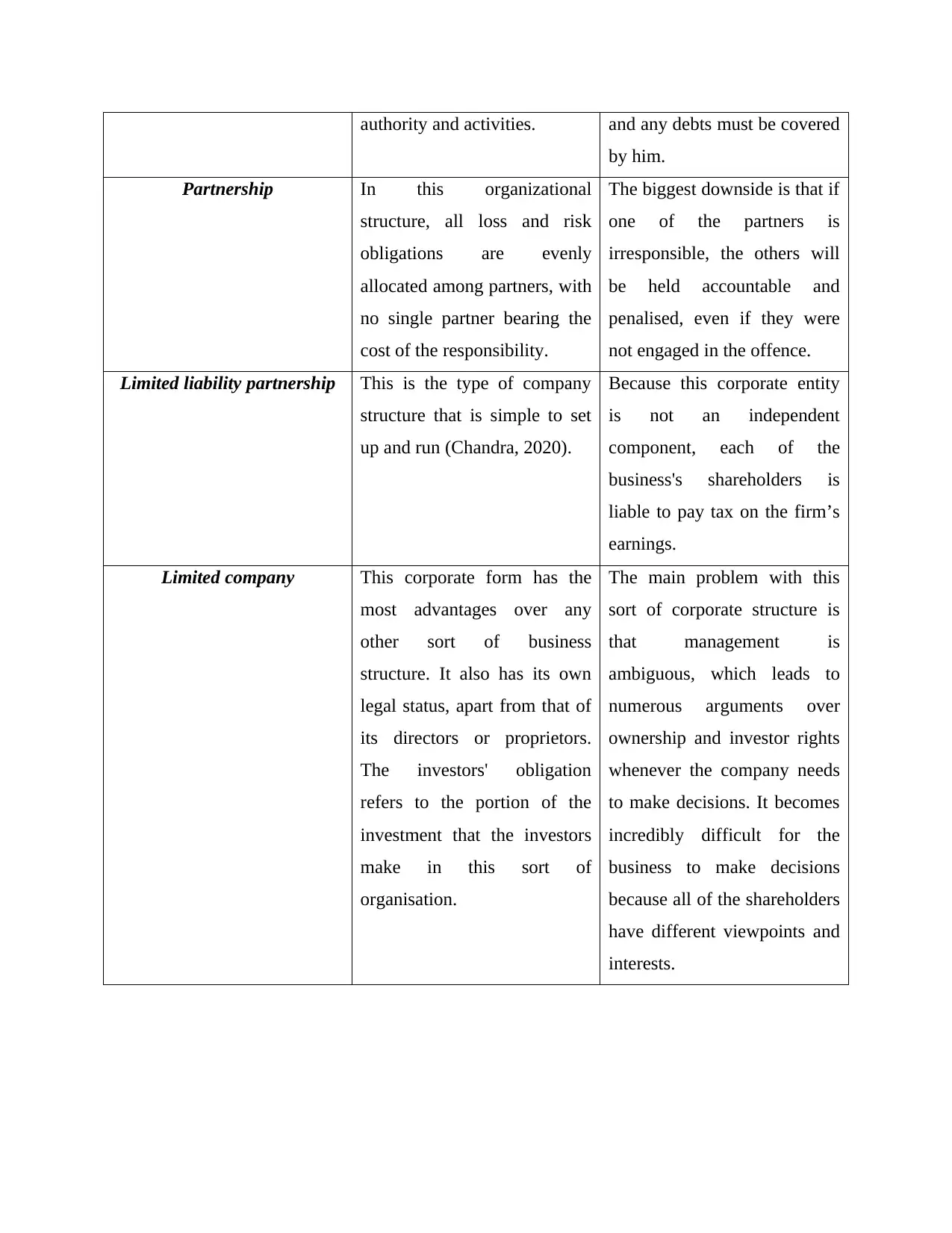
authority and activities. and any debts must be covered
by him.
Partnership In this organizational
structure, all loss and risk
obligations are evenly
allocated among partners, with
no single partner bearing the
cost of the responsibility.
The biggest downside is that if
one of the partners is
irresponsible, the others will
be held accountable and
penalised, even if they were
not engaged in the offence.
Limited liability partnership This is the type of company
structure that is simple to set
up and run (Chandra, 2020).
Because this corporate entity
is not an independent
component, each of the
business's shareholders is
liable to pay tax on the firm’s
earnings.
Limited company This corporate form has the
most advantages over any
other sort of business
structure. It also has its own
legal status, apart from that of
its directors or proprietors.
The investors' obligation
refers to the portion of the
investment that the investors
make in this sort of
organisation.
The main problem with this
sort of corporate structure is
that management is
ambiguous, which leads to
numerous arguments over
ownership and investor rights
whenever the company needs
to make decisions. It becomes
incredibly difficult for the
business to make decisions
because all of the shareholders
have different viewpoints and
interests.
by him.
Partnership In this organizational
structure, all loss and risk
obligations are evenly
allocated among partners, with
no single partner bearing the
cost of the responsibility.
The biggest downside is that if
one of the partners is
irresponsible, the others will
be held accountable and
penalised, even if they were
not engaged in the offence.
Limited liability partnership This is the type of company
structure that is simple to set
up and run (Chandra, 2020).
Because this corporate entity
is not an independent
component, each of the
business's shareholders is
liable to pay tax on the firm’s
earnings.
Limited company This corporate form has the
most advantages over any
other sort of business
structure. It also has its own
legal status, apart from that of
its directors or proprietors.
The investors' obligation
refers to the portion of the
investment that the investors
make in this sort of
organisation.
The main problem with this
sort of corporate structure is
that management is
ambiguous, which leads to
numerous arguments over
ownership and investor rights
whenever the company needs
to make decisions. It becomes
incredibly difficult for the
business to make decisions
because all of the shareholders
have different viewpoints and
interests.
⊘ This is a preview!⊘
Do you want full access?
Subscribe today to unlock all pages.

Trusted by 1+ million students worldwide
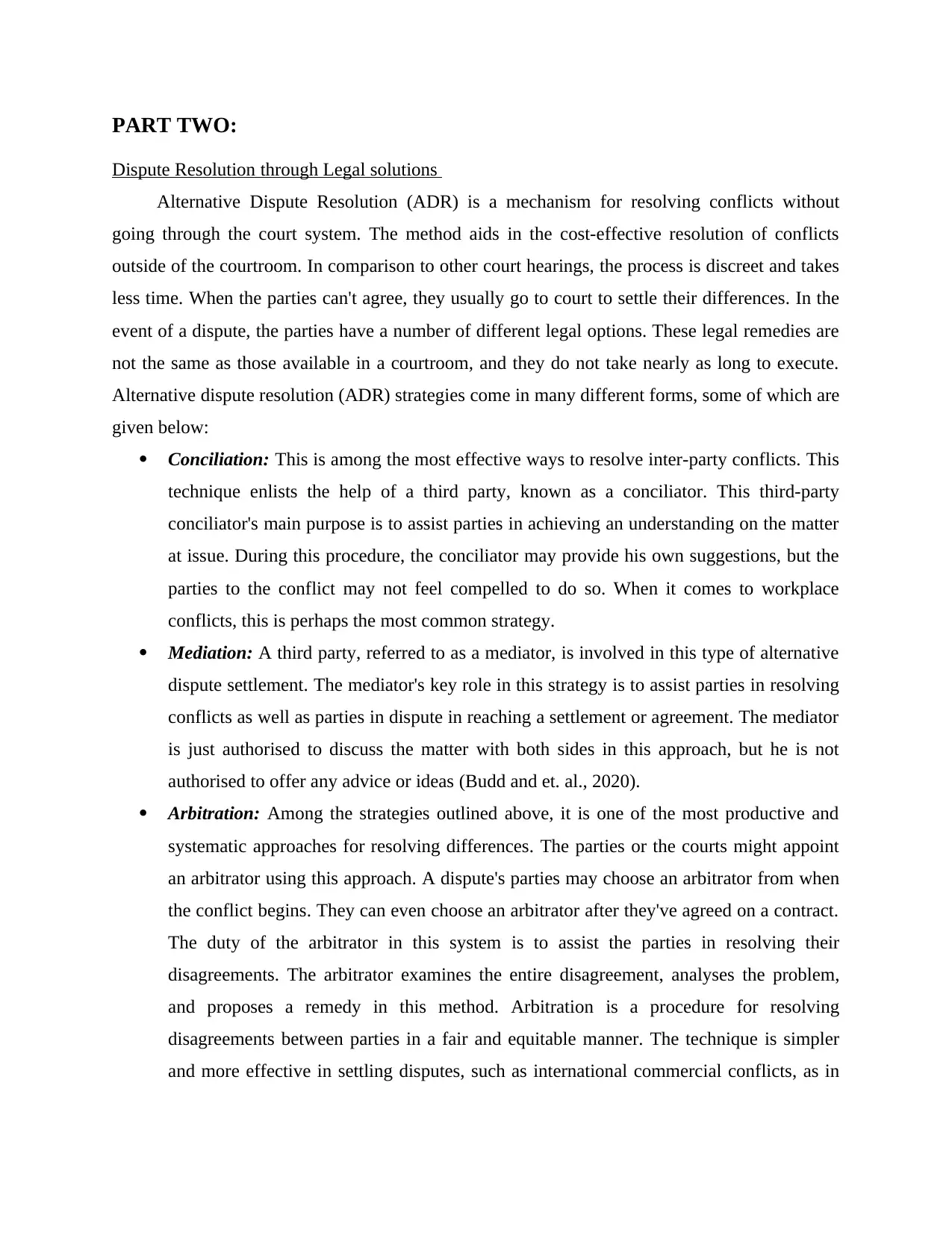
PART TWO:
Dispute Resolution through Legal solutions
Alternative Dispute Resolution (ADR) is a mechanism for resolving conflicts without
going through the court system. The method aids in the cost-effective resolution of conflicts
outside of the courtroom. In comparison to other court hearings, the process is discreet and takes
less time. When the parties can't agree, they usually go to court to settle their differences. In the
event of a dispute, the parties have a number of different legal options. These legal remedies are
not the same as those available in a courtroom, and they do not take nearly as long to execute.
Alternative dispute resolution (ADR) strategies come in many different forms, some of which are
given below:
Conciliation: This is among the most effective ways to resolve inter-party conflicts. This
technique enlists the help of a third party, known as a conciliator. This third-party
conciliator's main purpose is to assist parties in achieving an understanding on the matter
at issue. During this procedure, the conciliator may provide his own suggestions, but the
parties to the conflict may not feel compelled to do so. When it comes to workplace
conflicts, this is perhaps the most common strategy.
Mediation: A third party, referred to as a mediator, is involved in this type of alternative
dispute settlement. The mediator's key role in this strategy is to assist parties in resolving
conflicts as well as parties in dispute in reaching a settlement or agreement. The mediator
is just authorised to discuss the matter with both sides in this approach, but he is not
authorised to offer any advice or ideas (Budd and et. al., 2020).
Arbitration: Among the strategies outlined above, it is one of the most productive and
systematic approaches for resolving differences. The parties or the courts might appoint
an arbitrator using this approach. A dispute's parties may choose an arbitrator from when
the conflict begins. They can even choose an arbitrator after they've agreed on a contract.
The duty of the arbitrator in this system is to assist the parties in resolving their
disagreements. The arbitrator examines the entire disagreement, analyses the problem,
and proposes a remedy in this method. Arbitration is a procedure for resolving
disagreements between parties in a fair and equitable manner. The technique is simpler
and more effective in settling disputes, such as international commercial conflicts, as in
Dispute Resolution through Legal solutions
Alternative Dispute Resolution (ADR) is a mechanism for resolving conflicts without
going through the court system. The method aids in the cost-effective resolution of conflicts
outside of the courtroom. In comparison to other court hearings, the process is discreet and takes
less time. When the parties can't agree, they usually go to court to settle their differences. In the
event of a dispute, the parties have a number of different legal options. These legal remedies are
not the same as those available in a courtroom, and they do not take nearly as long to execute.
Alternative dispute resolution (ADR) strategies come in many different forms, some of which are
given below:
Conciliation: This is among the most effective ways to resolve inter-party conflicts. This
technique enlists the help of a third party, known as a conciliator. This third-party
conciliator's main purpose is to assist parties in achieving an understanding on the matter
at issue. During this procedure, the conciliator may provide his own suggestions, but the
parties to the conflict may not feel compelled to do so. When it comes to workplace
conflicts, this is perhaps the most common strategy.
Mediation: A third party, referred to as a mediator, is involved in this type of alternative
dispute settlement. The mediator's key role in this strategy is to assist parties in resolving
conflicts as well as parties in dispute in reaching a settlement or agreement. The mediator
is just authorised to discuss the matter with both sides in this approach, but he is not
authorised to offer any advice or ideas (Budd and et. al., 2020).
Arbitration: Among the strategies outlined above, it is one of the most productive and
systematic approaches for resolving differences. The parties or the courts might appoint
an arbitrator using this approach. A dispute's parties may choose an arbitrator from when
the conflict begins. They can even choose an arbitrator after they've agreed on a contract.
The duty of the arbitrator in this system is to assist the parties in resolving their
disagreements. The arbitrator examines the entire disagreement, analyses the problem,
and proposes a remedy in this method. Arbitration is a procedure for resolving
disagreements between parties in a fair and equitable manner. The technique is simpler
and more effective in settling disputes, such as international commercial conflicts, as in
Paraphrase This Document
Need a fresh take? Get an instant paraphrase of this document with our AI Paraphraser
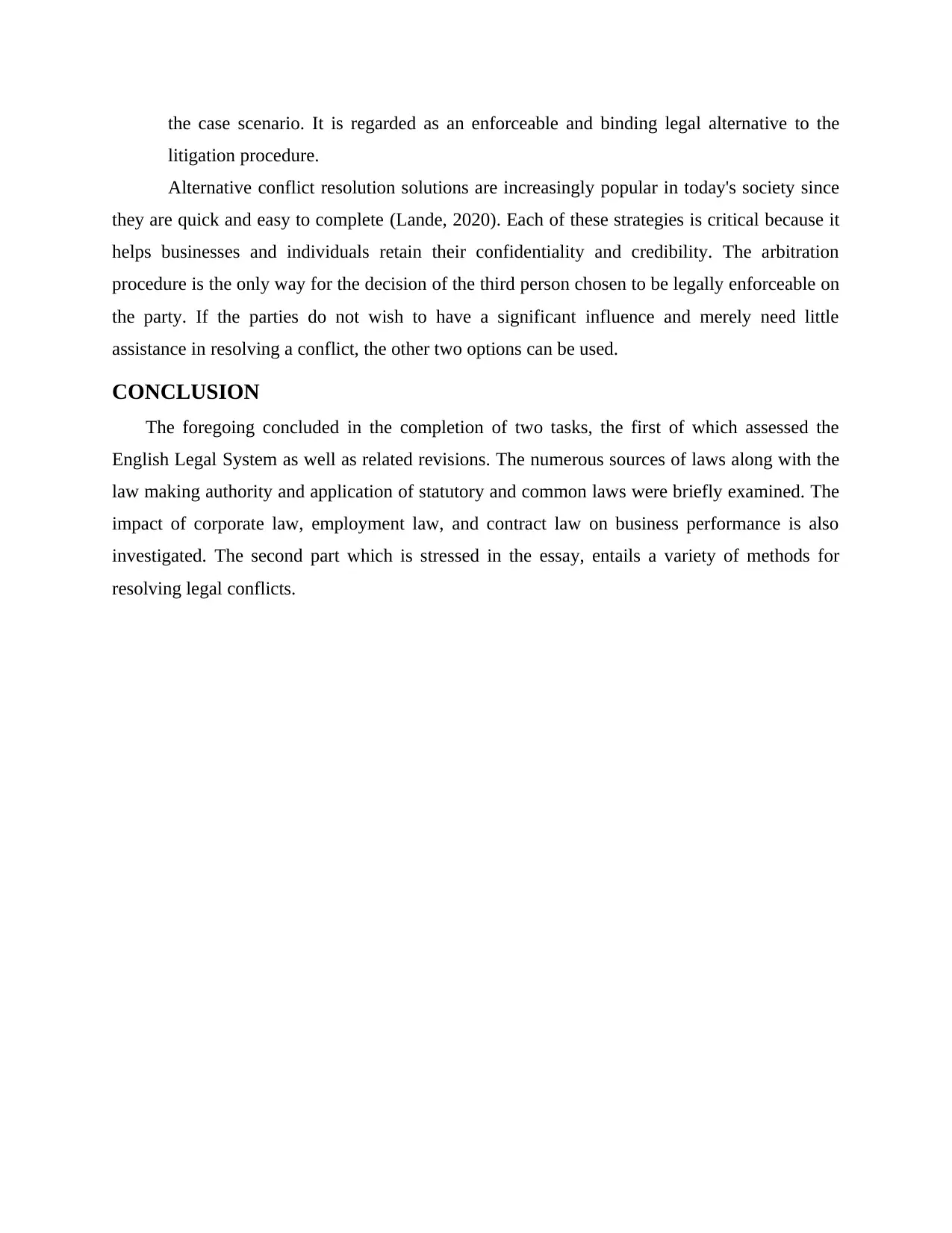
the case scenario. It is regarded as an enforceable and binding legal alternative to the
litigation procedure.
Alternative conflict resolution solutions are increasingly popular in today's society since
they are quick and easy to complete (Lande, 2020). Each of these strategies is critical because it
helps businesses and individuals retain their confidentiality and credibility. The arbitration
procedure is the only way for the decision of the third person chosen to be legally enforceable on
the party. If the parties do not wish to have a significant influence and merely need little
assistance in resolving a conflict, the other two options can be used.
CONCLUSION
The foregoing concluded in the completion of two tasks, the first of which assessed the
English Legal System as well as related revisions. The numerous sources of laws along with the
law making authority and application of statutory and common laws were briefly examined. The
impact of corporate law, employment law, and contract law on business performance is also
investigated. The second part which is stressed in the essay, entails a variety of methods for
resolving legal conflicts.
litigation procedure.
Alternative conflict resolution solutions are increasingly popular in today's society since
they are quick and easy to complete (Lande, 2020). Each of these strategies is critical because it
helps businesses and individuals retain their confidentiality and credibility. The arbitration
procedure is the only way for the decision of the third person chosen to be legally enforceable on
the party. If the parties do not wish to have a significant influence and merely need little
assistance in resolving a conflict, the other two options can be used.
CONCLUSION
The foregoing concluded in the completion of two tasks, the first of which assessed the
English Legal System as well as related revisions. The numerous sources of laws along with the
law making authority and application of statutory and common laws were briefly examined. The
impact of corporate law, employment law, and contract law on business performance is also
investigated. The second part which is stressed in the essay, entails a variety of methods for
resolving legal conflicts.
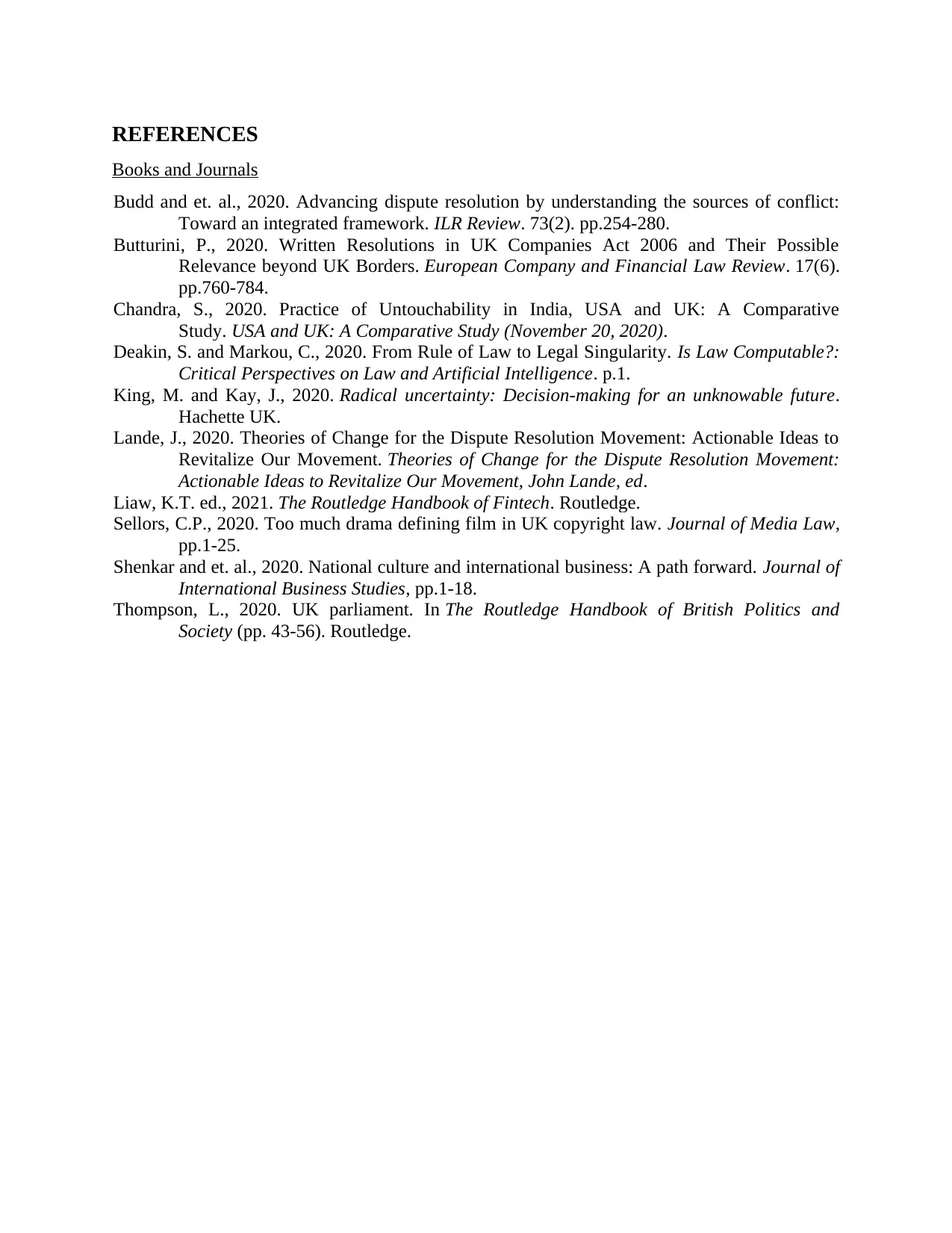
REFERENCES
Books and Journals
Budd and et. al., 2020. Advancing dispute resolution by understanding the sources of conflict:
Toward an integrated framework. ILR Review. 73(2). pp.254-280.
Butturini, P., 2020. Written Resolutions in UK Companies Act 2006 and Their Possible
Relevance beyond UK Borders. European Company and Financial Law Review. 17(6).
pp.760-784.
Chandra, S., 2020. Practice of Untouchability in India, USA and UK: A Comparative
Study. USA and UK: A Comparative Study (November 20, 2020).
Deakin, S. and Markou, C., 2020. From Rule of Law to Legal Singularity. Is Law Computable?:
Critical Perspectives on Law and Artificial Intelligence. p.1.
King, M. and Kay, J., 2020. Radical uncertainty: Decision-making for an unknowable future.
Hachette UK.
Lande, J., 2020. Theories of Change for the Dispute Resolution Movement: Actionable Ideas to
Revitalize Our Movement. Theories of Change for the Dispute Resolution Movement:
Actionable Ideas to Revitalize Our Movement, John Lande, ed.
Liaw, K.T. ed., 2021. The Routledge Handbook of Fintech. Routledge.
Sellors, C.P., 2020. Too much drama defining film in UK copyright law. Journal of Media Law,
pp.1-25.
Shenkar and et. al., 2020. National culture and international business: A path forward. Journal of
International Business Studies, pp.1-18.
Thompson, L., 2020. UK parliament. In The Routledge Handbook of British Politics and
Society (pp. 43-56). Routledge.
Books and Journals
Budd and et. al., 2020. Advancing dispute resolution by understanding the sources of conflict:
Toward an integrated framework. ILR Review. 73(2). pp.254-280.
Butturini, P., 2020. Written Resolutions in UK Companies Act 2006 and Their Possible
Relevance beyond UK Borders. European Company and Financial Law Review. 17(6).
pp.760-784.
Chandra, S., 2020. Practice of Untouchability in India, USA and UK: A Comparative
Study. USA and UK: A Comparative Study (November 20, 2020).
Deakin, S. and Markou, C., 2020. From Rule of Law to Legal Singularity. Is Law Computable?:
Critical Perspectives on Law and Artificial Intelligence. p.1.
King, M. and Kay, J., 2020. Radical uncertainty: Decision-making for an unknowable future.
Hachette UK.
Lande, J., 2020. Theories of Change for the Dispute Resolution Movement: Actionable Ideas to
Revitalize Our Movement. Theories of Change for the Dispute Resolution Movement:
Actionable Ideas to Revitalize Our Movement, John Lande, ed.
Liaw, K.T. ed., 2021. The Routledge Handbook of Fintech. Routledge.
Sellors, C.P., 2020. Too much drama defining film in UK copyright law. Journal of Media Law,
pp.1-25.
Shenkar and et. al., 2020. National culture and international business: A path forward. Journal of
International Business Studies, pp.1-18.
Thompson, L., 2020. UK parliament. In The Routledge Handbook of British Politics and
Society (pp. 43-56). Routledge.
⊘ This is a preview!⊘
Do you want full access?
Subscribe today to unlock all pages.

Trusted by 1+ million students worldwide
1 out of 12
Related Documents
Your All-in-One AI-Powered Toolkit for Academic Success.
+13062052269
info@desklib.com
Available 24*7 on WhatsApp / Email
![[object Object]](/_next/static/media/star-bottom.7253800d.svg)
Unlock your academic potential
Copyright © 2020–2025 A2Z Services. All Rights Reserved. Developed and managed by ZUCOL.





